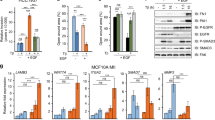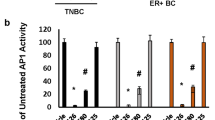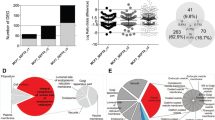Abstract
Signal transducers and activators of transcription (STATs) are latent transcription factors that mediate cytokine- and growth factor-induced transcription. Constitutive activation of STAT3 has been shown in human cancers and transformed cell lines. We report that STAT3, but not STAT1 and STAT5, becomes phosphorylated in response to epidermal growth factor (EGF) and achieves maximal induction of collagenase-1 (MMP-1) transcription by interacting with c-JUN. Phosphorylation of STAT3 protein is biphasic: the first peak within 30 min and the second peak between 4 and 8 h. Association of STAT3 with c-JUN is detected and its constituting STAT3 is increasingly phosphorylated. The STAT and AP-1 elements are necessary for effective induction of MMP-1 promoter by EGF. Mutation of AP-1 element closely located at the STAT site abolishes the binding not only of c-JUN but also of STAT3 to MMP-1 promoter, resulting in the loss of the responsiveness to EGF. By blocking STAT3 activity with the dominant-negative form, we show the requirement of STAT3 for EGF induction of MMP-1 and MMP-10 (stromelysin-2). Furthermore, expression of the dominant-negative STAT3 is sufficient to inhibit the constitutive and EGF-inducible cell migration and invasion and the tumor formation in nude mice. These results demonstrate that STAT3 phosphorylation and its possible interaction with c-JUN are required for the strong responsiveness of MMP-1 to EGF, and STAT3 activation is crucial for exhibition of malignant characteristics in T24 bladder cancer cells.
This is a preview of subscription content, access via your institution
Access options
Subscribe to this journal
Receive 50 print issues and online access
$259.00 per year
only $5.18 per issue
Buy this article
- Purchase on Springer Link
- Instant access to full article PDF
Prices may be subject to local taxes which are calculated during checkout






Similar content being viewed by others
References
Andl CD, Mizushima T, Nakagawa H, Oyama K, Harada H, Chruma K et al. (2003). J Biol Chem 278: 1824–1830.
Blaskovich MA, Sun J, Cantor A, Turkson J, Jove R, Sebti SM . (2003). Cancer Res 63: 1270–1279.
Bromberg JF, Horvath CM, Besser D, Lathem WW, Darnell Jr JE . (1998). Mol Cell Biol 18: 2553–2558.
Bromberg JF, Wrzeszczynska MH, Devgan G, Zhao Y, Pestell RG, Albanese C et al. (1999). Cell 98: 295−303.
Bromberg JF . (2001). Bioessays 23: 161–169.
Catlett-Falcone R, Landowski TH, Oshiro MM, Turkson J, Levitzki A, Savino R et al. (1999). Immunity 10: 105–115.
Catterall JB, Carrere S, Koshy PJ, Degnan BA, Shingleton WD, Brinckerhoff CE et al. (2001). Arthritis Rheum 44: 2296–2310.
Chambers AF, Matrisian LM . (1997). J Natl Cancer Inst 89: 1260–1270.
Ciardiello F, Tortora G . (2001). Clin Cancer Res 7: 2958–2970.
Crawford HC, Matrisian LM . (1996). Enzyme Protein 49: 20–37.
D'Armiento J, DiColandrea T, Dalal SS, Okada Y, Huang MT, Conney AH et al. (1995). Mol Cell Biol 15: 5732–5739.
Darnell Jr JE . (1997). Science 277: 1630–1635.
Dominguez-Escrig JL, Kelly JD, Neal DE, King SM, Davies BR . (2004). Clin Cancer Res 10: 4874–4884.
Fernandes A, Hamburger AW, Gerwin BI . (1999). Int J Cancer 83: 564–570.
Garcia R, Bowman TL, Niu G, Yu H, Minton S, Muro-Cacho CA et al. (2001). Oncogene 20: 2499–2513.
Grandis JR, Drenning SD, Chakraborty A, Zhou MY, Zeng Q, Pitt AS et al. (1998). J Clin Invest 102: 1385–1392.
Higashino F, Aoyagi M, Takahashi A, Ishino M, Taoka M, Isobe T et al. (2005). J Cell Biol 170: 15–20.
Higashino F, Yoshida K, Noumi T, Seiki M, Fujinaga K . (1995). Oncogene 10: 1461–1463.
Horton RM . (1997). Methods Mol Biol 67: 141–149.
Ivanov VN, Bhoumik A, Krasilnikov M, Raz R, Owen-Schaub LB, Levy D et al. (2001). Mol Cell 7: 517–528.
Karin M . (1995). J Biol Chem 270: 16483–16486.
Kira M, Sano S, Takagi S, Yoshikawa K, Takeda J, Itami S . (2002). J Biol Chem 277: 12931–12936.
Koop S, Khokha R, Schmidt EE, MacDonald IC, Morris VL, Chambers AF et al. (1994). Cancer Res 54: 4791–4797.
Korzus E, Nagase H, Rydell R, Travis J . (1997). J Biol Chem 272: 1188–1196.
Li WQ, Dehnade F, Zafarullah M . (2001). J Immunol 166: 3491–3498.
Liotta LA, Steeg PS, Stetler-Stevenson WG . (1991). Cell 64: 327–336.
Masuda M, Suzui M, Yasumatu R, Torahiko N, Kurotomi Y, Azuma K et al. (2002). Cancer res 62: 3351–3355.
Mendelsohn J, Baselga J . (2000). Oncogene 19: 6550–6565.
Minoguchi M, Minoguchi S, Aki D, Joo A, Yamamoto T, Yumioka T et al. (2003). J Biol Chem 278: 11182–11189.
Nagase H, Woessner Jr JF . (1999). J Biol Chem 274: 21491–21494.
Nakajima K, Yamanaka Y, Nakae K, Kojima H, Ichiba M, Kiuchi N et al. (1996). EMBO J 15: 3651–3658.
Niu G, Bowman T, Huang M, Shivers S, Reintgen D, Daud A et al. (2002a). Oncogene 21: 7001–7010.
Niu G, Wright KL, Huang M, Song L, Haura E, Turkson J et al. (2002b). Oncogene 21: 2000–2008.
Niwa H, Yamamura K, Miyazaki J . (1991). Gene 108: 193–200.
O'Shea JJ, Gadina M, Schreiber RD . (2002). Cell 109: S121–S131.
Price JT, Wilson HM, Haites NE . (1996). Eur J Cancer 32: 1977–1982.
Sano S, Itami S, Takeda K, Tarutani M, Yamagichi Y, Miura H et al. (1999). EMBO J 18: 4657–4668.
Shibata T, Kawano T, Nagayasu H, Okumura K, Arisue M, Hamada J et al. (1996). Tumour Biol 17: 168–175.
Silver DL, Naora H, Liu J, Cheng W, Montell DJ . (2004). Cancer Res 64: 3550–3558.
Turkson J, Jove R . (2000). Oncogene 19: 6613–6626.
Vihinen P, Kähäri VM . (2002). Int J Cancer 99: 157–166.
Wei D, Le X, Zheng L, Wang L, Frey JA, Gao AC et al. (2003). Oncogene 22: 319–329.
Westermarck J, Kähäri VM . (1999). FASEB J 13: 781–792.
Wu L, Wu Y, Gathings B, Wan M, Li X, Grizzle W et al. (2003). J Biol Chem 278: 15192–15200.
Yamashita S, Miyagi C, Carmany-Rampey A, Shimizu T, Fujii R, Schier AF et al. (2002). Dev Cell 2: 363–375.
Zhang X, Wrzeszczynska MH, Horvath CM, Darnell Jr JE . (1999). Mol Cell Biol 19: 7138–7146.
Acknowledgements
We thank LK Venkatesh for critical reading of the manuscript.
Author information
Authors and Affiliations
Corresponding author
Rights and permissions
About this article
Cite this article
Itoh, M., Murata, T., Suzuki, T. et al. Requirement of STAT3 activation for maximal collagenase-1 (MMP-1) induction by epidermal growth factor and malignant characteristics in T24 bladder cancer cells. Oncogene 25, 1195–1204 (2006). https://doi.org/10.1038/sj.onc.1209149
Received:
Revised:
Accepted:
Published:
Issue Date:
DOI: https://doi.org/10.1038/sj.onc.1209149
Keywords
This article is cited by
-
EGF-induced nuclear translocation of SHCBP1 promotes bladder cancer progression through inhibiting RACGAP1-mediated RAC1 inactivation
Cell Death & Disease (2022)
-
Selenium-binding protein 1 transcriptionally activates p21 expression via p53-independent mechanism and its frequent reduction associates with poor prognosis in bladder cancer
Journal of Translational Medicine (2020)
-
MicroRNA-125b exerts antitumor functions in cutaneous squamous cell carcinoma by targeting the STAT3 pathway
Cellular & Molecular Biology Letters (2020)
-
HPV16-Immortalized Cells from Human Transformation Zone and Endocervix are More Dysplastic than Ectocervical Cells in Organotypic Culture
Scientific Reports (2018)
-
Novel STAT binding elements mediate IL-6 regulation of MMP-1 and MMP-3
Scientific Reports (2017)



